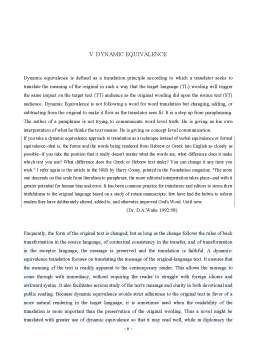Extras din referat
I. INTRODUCTION
In his/her work, a translator is confronted with the diversity of languages and, to a greater extent, with the diversity of cultures. It can prove to be quite a challenge finding the most appropriate technique of conveying the message in the target language (TL).
The cultural implications for translation may take several forms ranging from lexical content and syntax to ideologies and ways of life in a given culture. The translator also has to decide on the importance given to certain cultural aspects and to what extent it is necessary or desirable to translate them into the target language. The aims of the source text will also have implications for translation as well as the intended readership for both the source text and the target text. Considering the cultural implications for a translated text implies recognizing all of these problems and taking into account several possibilities before deciding on the solution which appears the most appropriate in each specific case. While reading excerpts from Eugene Nida’s book Principles of correspondence, I have found out that there are two basic orientations in a translation: the formal equivalence and the dynamic equivalence. I considered this subject interesting and appealing, and as a result I have chosen this topic for my project. Moreover, researching for this topic has helped me to better understand which method to choose (or choose both) when translating different types of texts.
II. EARLY FORMS OF EQUIVALENCE
Equivalence has always been a kernel concept in translation and its definition, relevance and applicability within the field of translation theory have caused controversy. Debates about equivalence have marked the development of translation studies in the past fifty years, forming a significant testing ground for hypotheses concerning the institutional legitimacy of the discipline.
Since ancient times , translators have observed that different situations call for different renderings. Sometimes it was a dilemma whether to choose a word-for-word translation rather than to adjust the message to the target audience. As an attempt to solve this problem, Cicero (106-43 B.C.) stated:
If I render word for word, the result will sound uncouth, and if compelled by necessity I alter anything in the order or wording, I shall seem to have departed from the function of a translator. (De optimo genere oratorum v.14)
(Nord 1997:4)
Later on, Bible translators such as Jerome (348-420) and Martin Luther (1483-1546) considered that, especially when translating extracts from the Bible, there are parts where nothing must be modified, including the word order, and other parts where it is more important to adapt the message to the target reader’s expectations.
The translator Eugene Nida was the one to name the two possibilities ˝formal equivalence˝ and ˝dynamic equivalence˝. Even if, at first, the two terms were invented to describe ways of translating the Bible, they are applicable to any translation.
According to Nida, ˝dynamic equivalence˝ denotes equivalence of extralinguistic communicative effect:
A translation of dynamic equivalence aims at complete naturalness of expression, and tries to relate the receptor to modes of behavior relevant within the context of his own culture; it does not insist that he understand the cultural patterns of the source-language context in order to comprehend the message. (Nida 1964:159)
(Nord 1997:5)
Preview document
Conținut arhivă zip
- Fidelity vs Transparency.doc
















